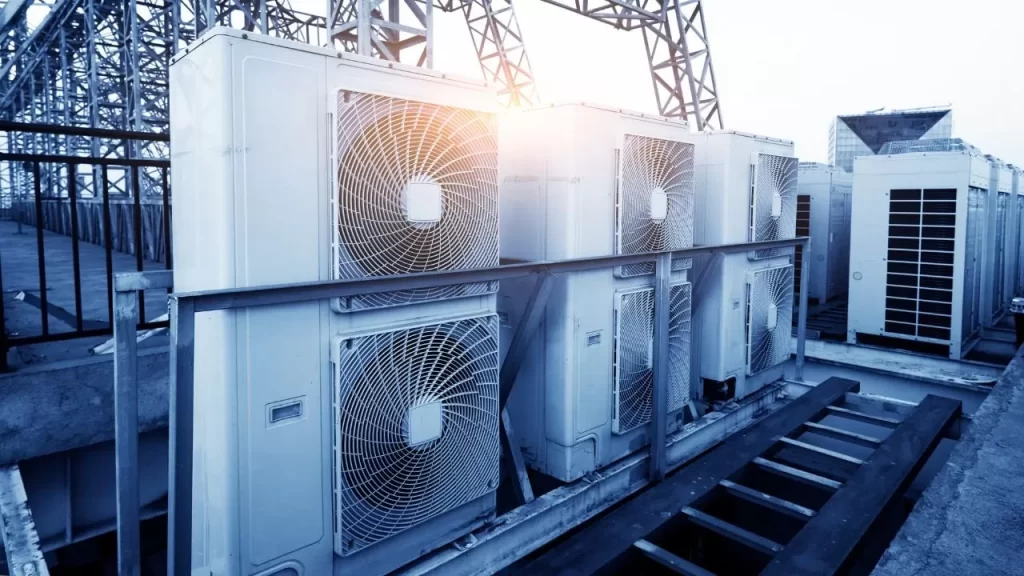The indoors of a common household get heated from lighting, people, and electronics. Similarly, factories and industrial units also experience internal heat gain
In fact, incrementally, and the amount is more than common households due to heavy machinery, technicians, manufacturing operations and so on.
Domestic ACs are not built to tackle this high internal heat gain.
They face a lot of technical challenges, which only an industrial AC can handle.



Challenges Domestic ACs Face in an Industrial Setup
Here is why a domestic air conditioning unit fails to work in a commercial setting.
- Insufficient Cooling Capacity
Domestic ACs are built to maintain an ambient indoor temperature in small rooms. These units are not capable of handling the massive internal heat gain of bigger industrial spaces. It’s only an industrial AC that can offer the best advantages in a commercial setting.
- Inadequate Airflow
Domestic units lack powerful airflow to cover a bigger industrial space with machines installed. These units will struggle to maintain proper temperature and moisture levels at every corner.
- Frequent Overloading
Domestic ACs are not built to run continuously under heavy cooling loads. They will not be able to neutralise the internal heat and may face frequent breakdowns.
- Limited Filtration
Higher footfall and machinery operating constantly increase the concentration of suspended particles in the indoor air. Domestic ACs can’t filter pollutants of high volume and may compromise the efficiency of machines and the health of operators.
- Drainage Limitations
Domestic ACs will not be able to handle a higher volume of condensed moisture in large spaces. It will cause poor drainage and leakage issues, damaging equipment or causing accidents.These limitations of domestic ACs will not serve the purpose if installed in commercial setups. Industrial units need more efficient cooling systems. Only an industrial cooling system such as a panel AC can regulate the interior temperature precisely.
Advantages of Industrial Cooling Systems over Domestic ACs
These points explain how industrial ACs are more engineered for cooling big factory setups.
Cooling Capacity
An industrial AC is more efficient than a domestic one in oversized commercial spaces. This obvious difference emphasizes how an industrial cooling unit can handle the huge amount of internal heat generated by operators and machinery.
A domestic AC can deliver up to 3 tons of cooling capacity. An industrial AC, in this aspect, can deliver up to 350 TR (tons of refrigeration) capacity considering the type used. It also means an industrial cooling system will consume way more energy than the domestic one.
Modular Components
Even if the cooling mechanism of industrial and domestic ACs is the same, they differ in terms of components. The heat exchange process needs complex components installed in a single cabinet. An industrial AC manufacturer focuses on precise temperature control inside a large space with operators and equipment present.
An industrial cooling unit generates more cooling power and can deliver different cooling effects. Such greater precision to tackle immense internal heat generation can only be achieved with high-performing modular components, absent in domestic cooling units.
Drainage System
A commercial cooling system possesses a better drainage system than a household air conditioning unit. It cools the air inside a bigger space and draws moisture out at a higher rate. This condensed moisture must be removed from the industrial space via the drainage system without causing any overflow issues.
This is why industrial ACs use special piping channels to flush out a large amount of condensed moisture. This piping system is safely installed to avoid damaging internal equipment or causing any industrial hazard.
Higher Airflow Capacity for Efficient Heat Dissipation
An industrial AC delivers a higher rate of airflow to cool down every nook and corner of an industrial space. Residential spaces, on the other hand, are simpler and emptier than industrial setups. Hence, the airflow capacity has to be stronger in industrial cooling systems than in domestic units to reach the ambient temperature inside.
Humidity and Temperature Control Precision
An industrial AC shows better cooling capacity than domestic ones. This level of precision can only be achieved with smart electronic systems. These systems can track even the slightest drop or increase in temperature and humidity inside an industrial unit.
The smart systems calibrate the flow of refrigerant to cool the air and control the indoor temperature for optimum operations. Domestic ACs don’t have to be that precise due to the absence of sensitive equipment and low footfall.
Air Filtration
An industrial AC has an excellent air filtration unit to keep the industrial units free from suspended particulate matter. These particles can cause immense harm to equipment and also bring down the quality of manufactured products. Also, industrial cooling systems must comply with the regulatory standards of a specific industry.
Location of AC Units
Domestic ACs are generally installed high on the walls with the external units set outside. Industrial ACs can be of different types. For instance, a panel AC can be set on the floor in a precise location inside an industrial unit. Chillers, on the other hand, are bigger units installed in a dedicated space and the airflow is distributed by an intricate channel of vents.
Know More about Industrial Cooling with Tempcon: India’s Leading Industrial AC Manufacturer
Suspendisse placerat eu metus vulputate mollis. Quisque egestas nunc tortor, ut vehicula ligula gravida sit amet. Morbi magna magna, facilisis fermentum tristique nec, dapibus non purus. Fusce in justo eget tortor maximus molestie. Aenean posuere maximus lacinia. Duis enim tellus, scelerisque sed justo ut, tincidunt placerat felis. Mauris laoreet sed urna id efficitur.
Praesent lacinia dolor quis mollis mollis. Etiam aliquet ultrices metus, sed auctor ex pretium at. Pellentesque at nibh ac tortor varius ornare. Donec eu ornare nulla. Vivamus maximus pulvinar quam a pellentesque. Sed posuere fringilla sem ut congue.



